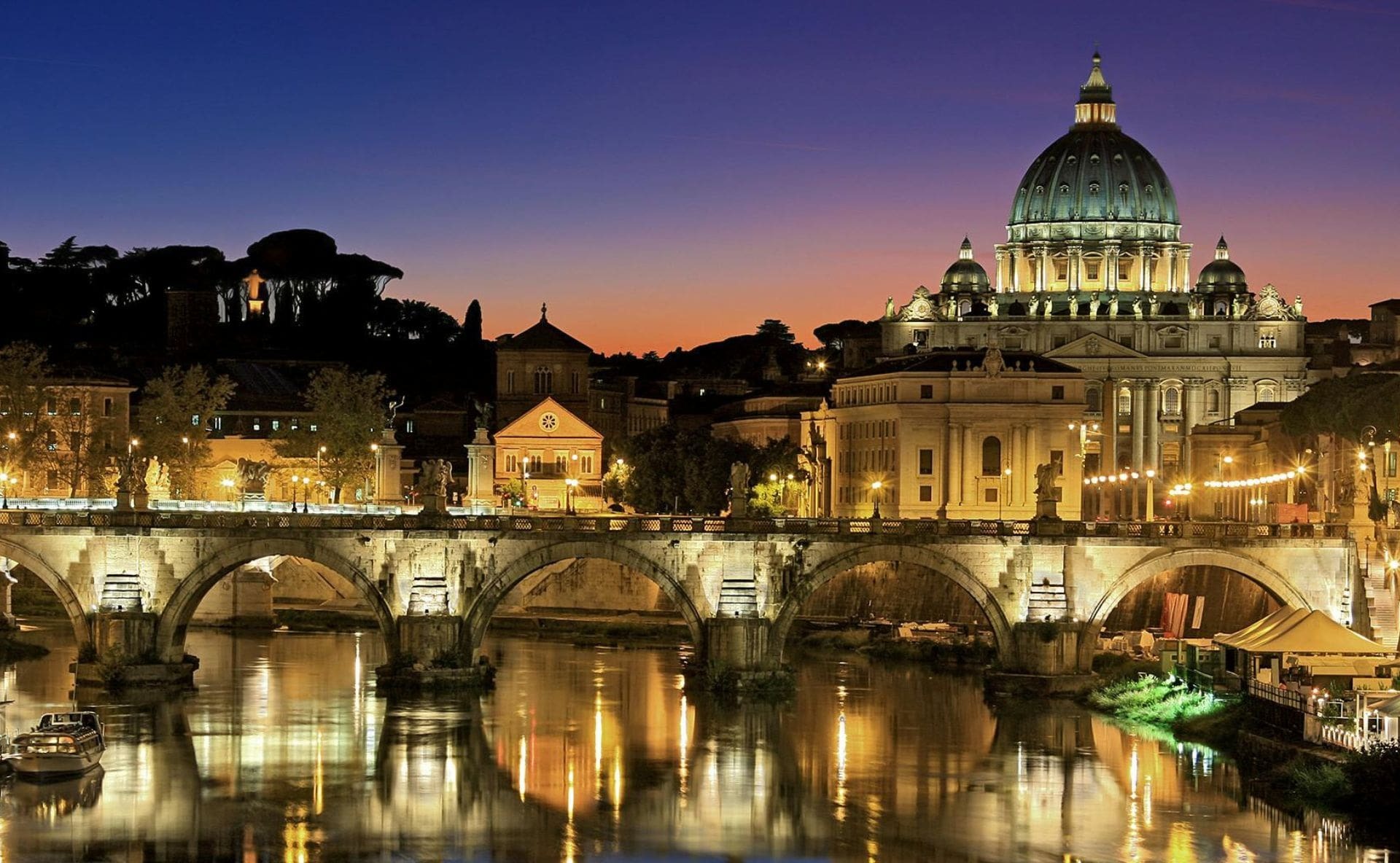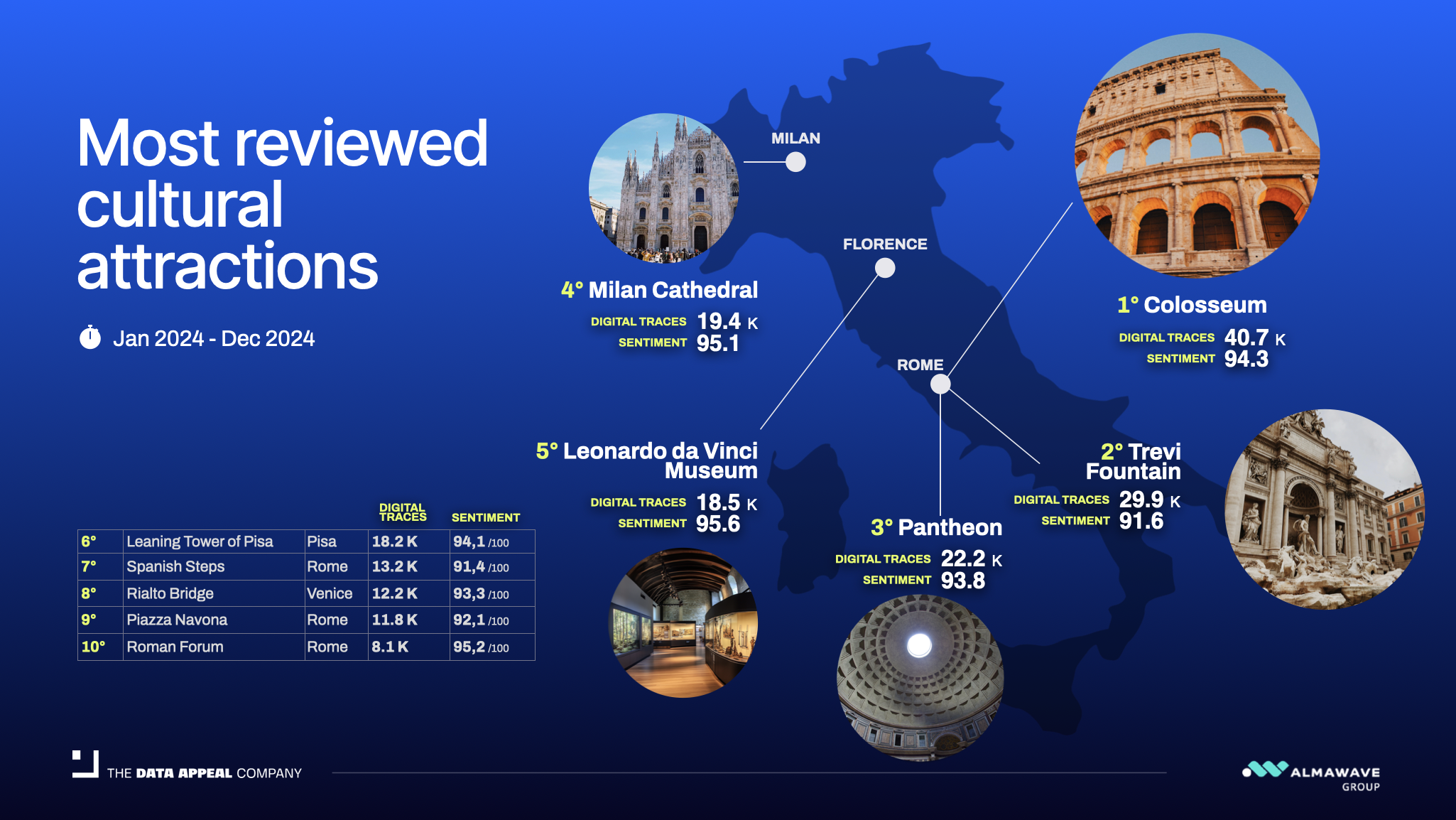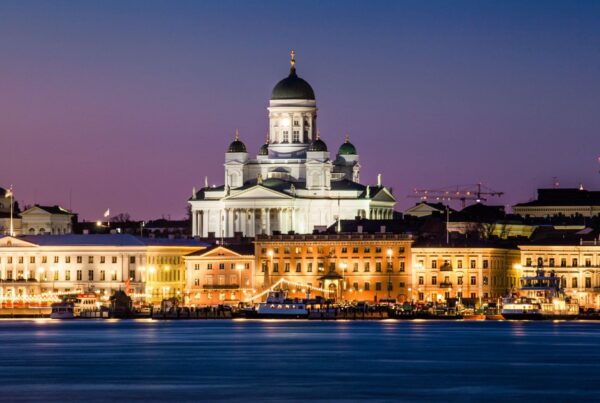Cultural tourism in Italy has long been a vital part of its identity. But what is the country’s most-loved cultural attraction? And when it comes to museums, does the most-reviewed one align with the most famous? Rome, Florence, and Venice are classics—but what about Italy’s other cities and towns? By analysing over 9 million digital traces with D / AI Destinations, we’ve captured a high-definition snapshot of cultural tourism in Italy.
With 60 UNESCO sites (including its cuisine as a candidate to be a UNESCO World Heritage Site), over 4,000 museums, and over 6,000 archeological sites, Italy remains one of the world’s top cultural destinations, ranking as the third most-visited country in Europe, and fifth most-visited country in the world.
We all know the cultural icons—Rome’s Colosseum, Florence’s Uffizi Gallery, the Leaning Tower of Pisa, and more. But are these really the places visitors talk about or appreciate the most?
By analysing digital traces we can see what truly captures travellers’ attention. And in 2024, the results were surprising.
With insights from over 9 million digital traces via D / AI Destinations, here’s what the data tells us about Italy’s cultural hotspots.
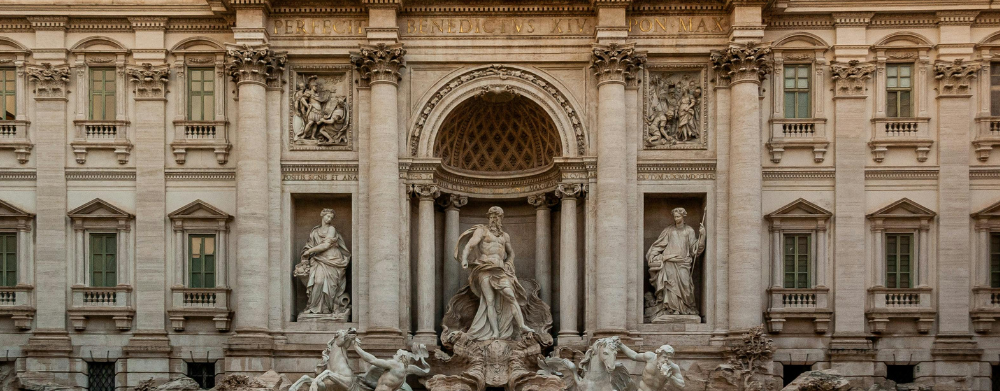
The walkway to a new era for the Trevi Fountain
For centuries, the Trevi Fountain has been one of the most visited spots in Rome. But in 2024, it gained a new level of digital fame, surpassing the Pantheon to secure a spot among the most-reviewed and highest-rated cultural attractions, with interest in the Trevi Fountain increasing following the 2024 launch of a special walkway with limited access.
In just its first weekend, 14,000 visitors used the walkway, and over €4,600 in coins tossed into the fountain were gathered for Caritas Roma. The improved access meant:
- Fewer bottlenecks
- Better photo opportunities
- A smoother visitor experience
- Better engagement
However, this surge in digital attention also had an unexpected effect. While the Fontana di Trevi maintained an exceptional sentiment score of 91/100, the sheer volume of discussions led to a slight 2% dip compared to the previous year.
Even so, it remains one of Italy’s most celebrated cultural landmarks, proving that small infrastructure changes can have a big impact.
Most attractions digital traces lead to Rome
Rome continues to be the hub of Italian cultural tourism, with 6 of the 10 most-reviewed attractions located in the the Eternal City. The Colosseum tops the list with the most reviews—40.7k, followed by the Trevi Fountain in second place (29.9k). The Pantheon comes in third (22.2k), while the Spanish Steps hold seventh place (13.2k). Piazza Navona ranks ninth (11.8k), and the Roman Forum rounds out the top 10 in tenth place (8.1k).
These iconic landmarks demonstrate Rome’s enduring digital dominance in the tourism scene.
Florence is the museum capital
Four of the top 10 most reviewed and appreciated museums in Italy are in Florence, reinforcing its reputation as the museum capital.
These include:
- Uffizi Gallery – A cultural giant with over 120,000 reviews, making it the most reviewed museum in Italy. Despite its established reputation, it continues to maintain strong visitor engagement.
- Accademia Gallery of Florence – Home to Michelangelo’s David, with a sentiment of 91.1
- Leonardo Interactive Museum — A museum showcasing invention models, designs, and replicas of Leonardo da Vinci’s artwork
- Leonardo da Vinci Museum – The most reviewed museum of 2024, with over 28,000 reviews and a Sentiment Score of 95.6/100. It has more than doubled its digital presence compared to the previous year, demonstrating the power of online reputation in attracting visitors.
It’s not just Florence—overall perceived quality of museums across Italy remains high, with 9 out of 10 museums exceeding a Sentiment Score of 90/100.
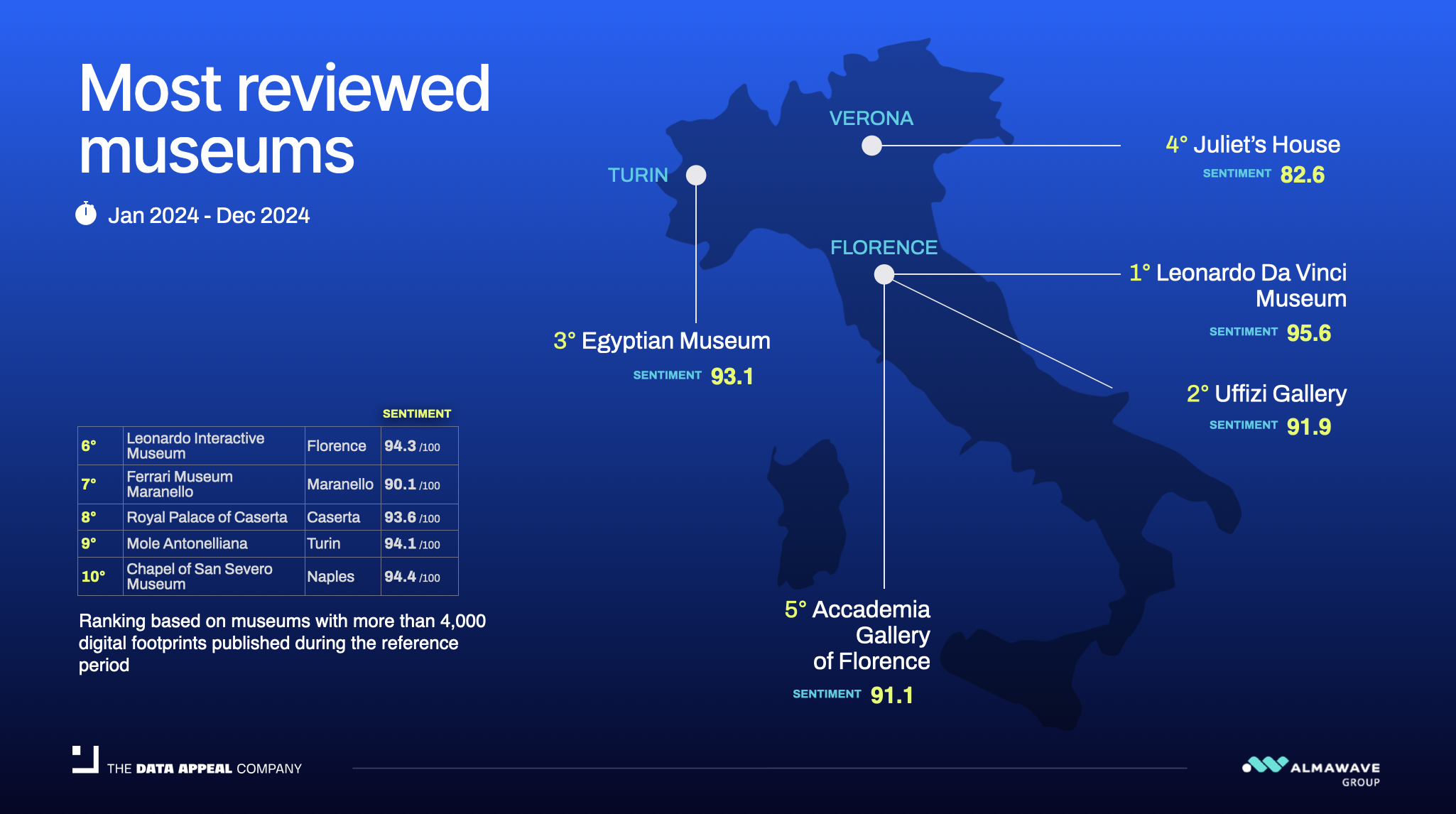
A surprise contender for one of the top museums emerges
The Leonardo da Vinci Museum in Florence has made remarkable strides in the digital space, surpassing some of Italy’s most renowned cultural institutions in terms of online interest in 2024.
Despite being a private museum, it has leveraged digital platforms effectively, doubling its digital footprint and achieving unprecedented visibility this year.
With over 28,000 online reviews, it has positioned itself as one of the most reviewed museums, even though it doesn’t yet match the volume of reviews seen by giants like the Uffizi or the Egyptian Museum.
What sets the Leonardo da Vinci Museum apart is its proactive approach to digital engagement, which has not only driven an impressive number of reviews but also earned it a stellar sentiment score of 95.6/100.
This highlights the growing importance of online reputation for cultural institutions, both public and private, in attracting visitors and maintaining their appeal in an increasingly digital world.
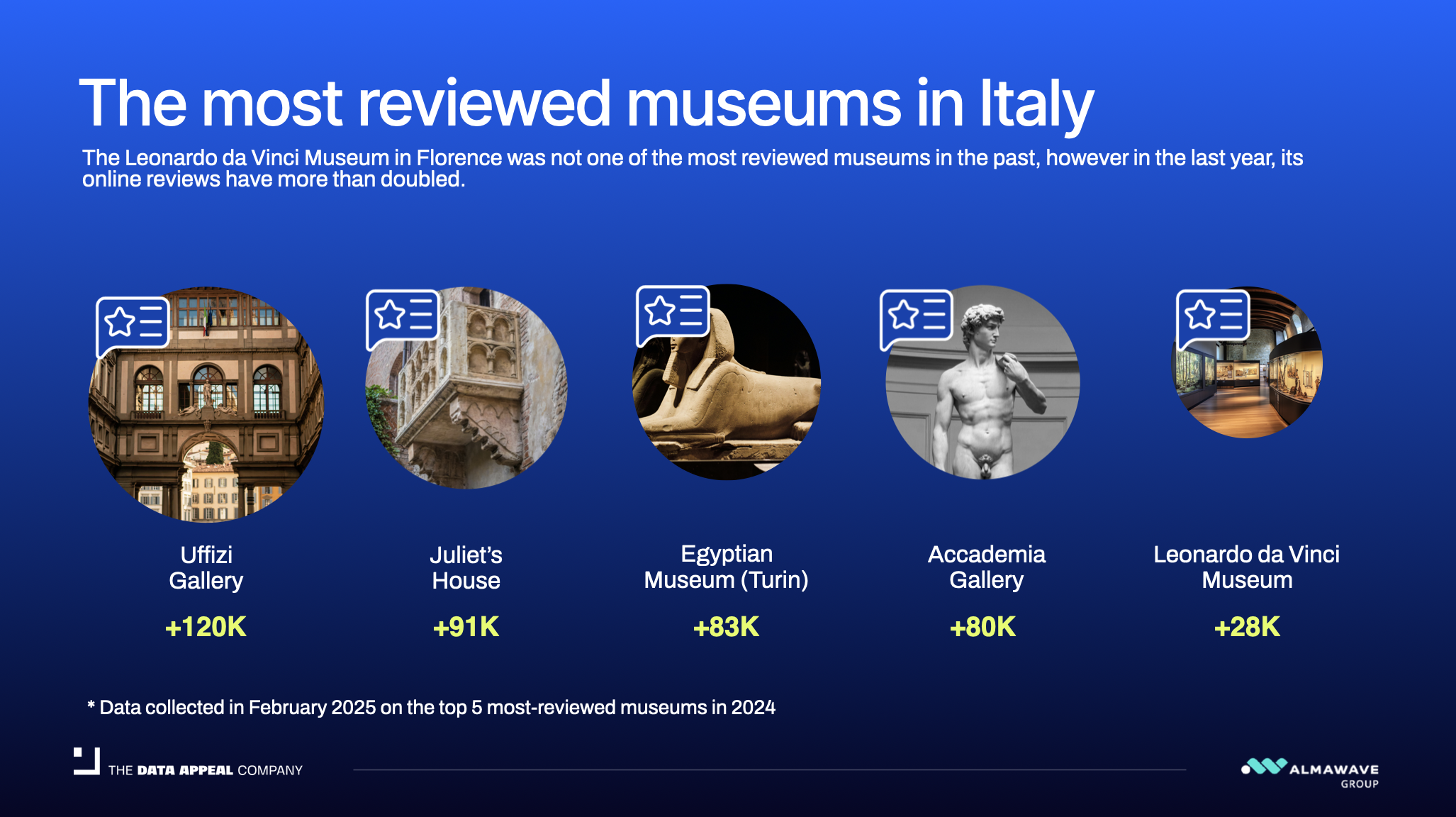
Cultural tourism thrives as sentiment and demand grow
Italy’s cultural appeal continues to rise, with overall sentiment reaching 86/100 and cultural attractions exceeding 92/100, showing further improvement from 2023. The country’s top art cities—Florence, Milan, Rome, Venice, and Naples—continue to set the standard, with cultural sites earning impressive ratings above 90/100 and a positive growth trend in nearly all destinations. This enthusiasm is also reflected on online booking platforms: while accommodation saturation has slightly declined compared to 2023, average rates have increased by 6–7%, signalling strong tourism demand. Additionally, operators are increasingly favouring direct bookings, further shaping the market dynamics.

Couples lead cultural tourism in Italy as visitor trends shift
Italy’s cultural tourism scene in 2024 tells a story of shifting dynamics and enduring appeal. Italian travellers remain the largest group, making up 34.8% of the digital footprint, though their presence has dipped slightly from 35.9% last year. Meanwhile, Germany (6.8%, down from 7.0%), France (6.1%, up from 5.9%), and the UK (4.5%, down from 4.7%) continue to be key markets, though their footprints have shifted. Spain, however, bucks the trend with a modest increase to 4.4% from 4.2%.
Who are these travellers? Mostly couples, making up 45% of cultural tourists, strolling through Italy’s historic streets and romantic landscapes. Families follow at 29%, seeking shared experiences, while 14% travel in groups, and 12% embark on solo adventures.
Sentiment remains overwhelmingly positive—especially among British travellers, who score 85.2/100, the highest among the major visitor markets.
American visitors have slightly declined (3.4%, down from 3.6%), as have the Swiss (2.8%, down from 2.9%). However, Poland (2.7%, up from 2.4%), Brazil (2.3%, up from 2.1%), and Austria (1.9%, stable) are showing an increasing interest in Italy’s cultural treasures.
Despite these shifts, Italy’s magic remains intact, as reflected in the consistently high sentiment scores—86.6/100 among American travellers, 85.7/100 for Polish visitors, and 84.5/100 for Brazilians.
Steady trends in digital traces for cultural sites, with peaks during key holidays
Digital traces and sentiment related to cultural sites follow the same trends as last year, with 9.2 million this year compared to 10.7 million last year. Unlike other vacation spots, review peaks for art cities are recorded during long weekends and holidays, such as Easter, May 1st, November 1st, and Ferragosto (an Italian holiday celebrated on August 15th), mirroring the flow of visitors to these destinations.
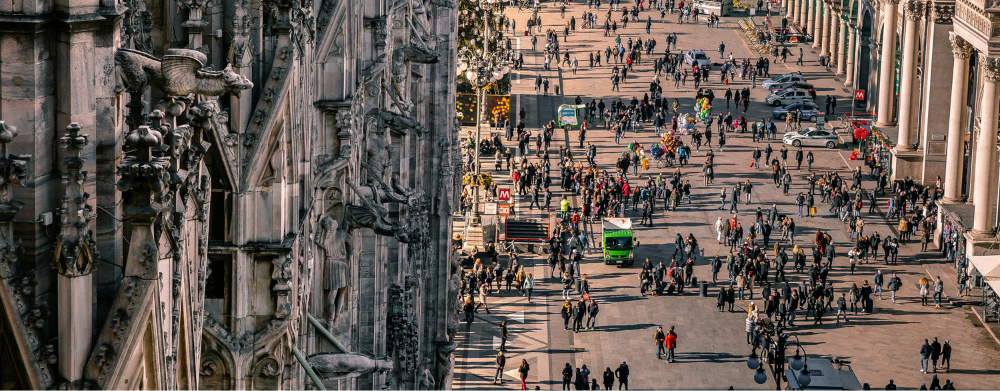
Positive impressions on environment and location, but safety and organisation still raise concerns
Among the most frequently mentioned themes in cultural attraction reviews, the environment, space, and location receive overwhelmingly positive feedback. Guests often highlight these aspects as key factors contributing to their satisfaction. However, concerns regarding safety and organisation continue to emerge, with some reviews pointing out areas in need of improvement. These critical aspects suggest that while the overall experience is favourable, attention to safety measures and better organisational practices could further enhance guest satisfaction.
Elevating cultural tourism through data-driven insights
Italy’s cultural tourism continues to flourish, with both well-known landmarks and emerging attractions capturing the attention of global visitors.
And as digital engagement rises, managing online reputation has never been more critical.
With D / AI Destinations, the comprehensive destination management and marketing platform, we help destinations tap into the power of digital footprints and sentiment analysis to gain valuable insights into visitor behaviour. This data-driven approach enables cities and cultural sites to refine their marketing strategies, enhance the visitor experience, and stay ahead of trends, ultimately driving sustainable growth and improving overall satisfaction.


